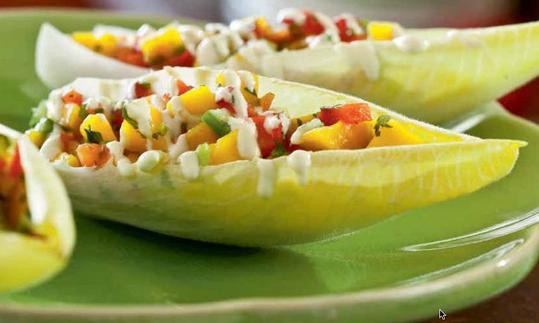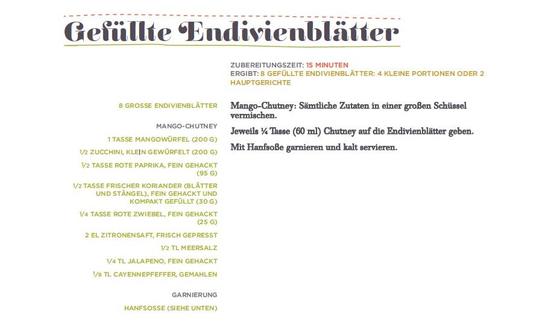Stuffed endive leaves with mango chutney and hemp sauce
raw-vegan
Ingredients (for servings, )
| For the mango chutney | |
|---|---|
| 7 ⅓ oz | Mangos, raw (organic?) |
| 7 ⅓ oz | Zucchini, raw, (organic?) |
| 3 ½ oz | Sweet peppers, red, raw (organic?) |
| 1 oz | Coriander leaves, raw |
| ¼ | Jalapeño, raw (organic?) (0.12 oz) |
| ⅞ oz | Onions, raw (organic?) |
| 2 tbsp | Lemon juice (raw?, organic?) (0.51 oz) |
| ½ tsp | Sea salt (raw?, organic?) (0.09 oz) |
| ⅛ tsp | Cayenne pepper (raw?, organic?) (0.01 oz) |
| For the hemp sauce | |
| 4 ⅓ oz | Cauliflower, raw (organic?) |
| 1 tbsp chopped | Chives, raw (organic?) (0.11 oz) |
| 2 ⅛ oz | Hemp seeds, unpeeled, raw, organic? |
| 185 ml | Drinking water, raw (organic?) (6.5 oz) |
| 125 ml | Sunflower oil (cold pressed? raw? organic?) (4.1 oz) |
| 125 ml | Olive oil (cold pressed, raw?, organic?) (4.0 oz) |
| 60 ml | Lemon juice (raw?, organic?) (2.2 oz) |
| 2 tbsp | Apple cider vinegar (raw?, organic?) (1.0 oz) |
| 1 tsp | Sea salt (raw?, organic?) (0.18 oz) |
| ¼ tsp, ground | Black pepper (organic?, raw?) (0.02 oz) |
| 2 tsp | Yeast flakes: noble yeast, nutritional yeast, yeast powder (raw?, organic?) (0.09 oz) |
| For serving | |
| 8 leaves | Chicory (raw, organic?) (2.1 oz) |
Equipment
- hand-held blender / immersion blender or blender
- citrus juicer (lemon squeezer)
Type of preparation
- chop or grind
- blend
- squeeze
- peel
Preparation
For the mango chutney
Peel and dice the mango and place it in a large bowl. Wash the zucchini, dice very finely and add it.Finely chop the pepper, coriander leaves, jalapeno and onion and add them as well. Mix everything with the lemon juice, sea salt and cayenne pepper.
If you are freshly squeezing the lemon juice for this recipe, you will need a citrus press and about two medium-sized lemons (about 120g each) for a quantity of 4 people.
For the hemp sauce
Wash the cauliflower and chives, chop finely and place in a blender.Add hemp seeds, water, oils, lemon juice, apple cider vinegar, salt, pepper and nutritional yeast to the blender. Puree until you have a smooth dressing.
For serving
Pluck the endive leaves, wash them thoroughly and shake them dry. Add mango chutney (approx. 60 ml per leaf) to the leaves and garnish the filled endive leaves with the hemp sauce.
|
Nutritional Information per person
Convert per 100g
|
2000 kcal | |
|---|---|---|
| Energy | 646 kcal | 32.3% |
| Fat/Lipids | 63 g | 89.9% |
| Saturated Fats | 7.5 g | 37.7% |
| Carbohydrates (inc.dietary fiber) | 20 g | 7.4% |
| Sugars | 11 g | 12.1% |
| Fiber | 7.9 g | 31.8% |
| Protein/Albumin | 6.5 g | 12.9% |
| Cooking Salt (Na:738.6 mg) | 1'876 mg | 78.2% |
| Essential micronutrients with the highest proportions | per person | 2000 kcal | |
|---|---|---|---|
| Fat | Linoleic acid; LA; 18:2 omega-6 | 25 g | 247.0% |
| Vit | Vitamin E, as a-TEs | 18 mg | 153.0% |
| Vit | Vitamin C (ascorbic acid) | 84 mg | 105.0% |
| Sodium, Na | 739 mg | 92.0% | |
| Vit | Vitamin K | 55 µg | 73.0% |
| Fat | Alpha-Linolenic acid; ALA; 18:3 omega-3 | 1.1 g | 55.0% |
| Vit | Folate, as the active form of folic acid (née vitamin B9 and | 91 µg | 45.0% |
| Min | Copper, Cu | 0.42 mg | 42.0% |
| Min | Manganese, Mn | 0.84 mg | 42.0% |
| Vit | Thiamine (vitamin B1) | 0.43 mg | 39.0% |
Detailed Nutritional Information per Person for this Recipe
The majority of the nutritional information comes from the USDA (US Department of Agriculture). This means that the information for natural products is often incomplete or only given within broader categories, whereas in most cases products made from these have more complete information displayed.
If we take flaxseed, for example, the important essential amino acid ALA (omega-3) is only included in an overarching category whereas for flaxseed oil ALA is listed specifically. In time, we will be able to change this, but it will require a lot of work. An “i” appears behind ingredients that have been adjusted and an explanation appears when you hover over this symbol.
For Erb Muesli, the original calculations resulted in 48 % of the daily requirement of ALA — but with the correction, we see that the muesli actually covers >100 % of the necessary recommendation for the omega-3 fatty acid ALA. Our goal is to eventually be able to compare the nutritional value of our recipes with those that are used in conventional western lifestyles.
| Essential fatty acids | per person | 2000 kcal |
|---|---|---|
| Linoleic acid; LA; 18:2 omega-6 | 25 g | 247.0% |
| Alpha-Linolenic acid; ALA; 18:3 omega-3 | 1.1 g | 55.0% |
| Essential amino acids | per person | 2000 kcal |
|---|---|---|
| Tryptophan (Trp, W) | 0.09 g | 37.0% |
| Threonine (Thr, T) | 0.22 g | 23.0% |
| Isoleucine (Ile, I) | 0.24 g | 19.0% |
| Valine (Val, V) | 0.30 g | 19.0% |
| Phenylalanine (Phe, F) | 0.26 g | 17.0% |
| Lysine (Lys, K) | 0.31 g | 16.0% |
| Leucine (Leu, L) | 0.34 g | 14.0% |
| Methionine (Met, M) | 0.10 g | 11.0% |
| Vitamins | per person | 2000 kcal |
|---|---|---|
| Vitamin E, as a-TEs | 18 mg | 153.0% |
| Vitamin C (ascorbic acid) | 84 mg | 105.0% |
| Vitamin K | 55 µg | 73.0% |
| Folate, as the active form of folic acid (née vitamin B9 and | 91 µg | 45.0% |
| Thiamine (vitamin B1) | 0.43 mg | 39.0% |
| Vitamin B6 (pyridoxine) | 0.38 mg | 27.0% |
| Riboflavin (vitamin B2) | 0.18 mg | 13.0% |
| Vitamin A, as RAE | 98 µg | 12.0% |
| Niacin (née vitamin B3) | 1.6 mg | 10.0% |
| Pantothenic acid (vitamin B5) | 0.62 mg | 10.0% |
| Biotin (ex vitamin B7, H) | 4.7 µg | 9.0% |
| Vitamin B12 (Cobalamin) | 0.01 µg | 1.0% |
| Essential macroelements (macronutrients) | per person | 2000 kcal |
|---|---|---|
| Sodium, Na | 739 mg | 92.0% |
| Potassium, K | 644 mg | 32.0% |
| Magnesium, Mg | 108 mg | 29.0% |
| Calcium, Ca | 87 mg | 11.0% |
| Phosphorus, P | 58 mg | 8.0% |
| Essential trace elements (micronutrients) | per person | 2000 kcal |
|---|---|---|
| Copper, Cu | 0.42 mg | 42.0% |
| Manganese, Mn | 0.84 mg | 42.0% |
| Iron, Fe | 2.6 mg | 18.0% |
| Zinc, Zn | 1.4 mg | 14.0% |
| Fluorine, F | 57 µg | 2.0% |
| Iod, I (Jod, J) | 2.9 µg | 2.0% |
| Selenium, Se | 0.78 µg | 1.0% |
The stuffed endive leaves with mango chutney and hemp sauce are a fruity and hearty summer dish that can be served as a side dish or starter.
High fat and salt content: The high fat and salt content in the nutritional table is almost exclusively due to the hemp sauce. We have to admit that the authors probably did not intend the entire sauce to be consumed. For this reason, you can achieve a healthier nutrient composition by reducing the amount of sauce and generally reducing the amount of salt and oil.
For health reasons, we have designed and tested an alternative recipe that primarily has differences in the composition of the ingredients. The following link will take you to the recipe mentioned: Healthy, stuffed salad leaves with fruity mango chutney. Please read the link behind this motivation: Vegans often eat unhealthily. Avoidable nutritional errors.
The term chicory or endive: The two ingredients are different foods, but the use of the terms varies from country to country. What is known as "chicory" in Germany and Switzerland is called "endive" by the Belgians and French. It is assumed that the fact that the two leafy vegetables belong to the same family has led to this confusion in names.
This recipe picture shows leaves of a vegetable known in German-speaking countries as chicory, but the original title mentions "endivie". This is due to the two authors, David Côté and Mathieu Gallant, and their connection to Quebec, the Canadian province with the largest French-speaking population.
Coriander: Opinions vary widely regarding the taste of coriander. Some people react to its intense, slightly soapy aroma with aversion or even nausea. According to statistics in Switzerland, 15% of all allergy sufferers are sensitive to coriander. In these cases, simply leave this ingredient out. However, it is the coriander that gives the dish its exotic note. There is no alternative with a similar taste. Flat-leaf parsley, which looks similar, has a completely different taste. Nevertheless, it is often used as a substitute.
Lemons for the lemon juice: If you want to squeeze the juice fresh, you will need the appropriate device (citrus press) and around 1 ½ lemons weighing approx. 120 g for the specified amount of 60 ml of lemon juice.
Recognizing ripe mangos: To get the intense, fruity flavor, it is important to use ripe mangos. You can recognize them by the fact that they can be easily pressed, but do not yet have any bruises.
Number of servings: As the authors have noted, you can use this recipe to serve the leaves as a side dish, i.e. as small portions, with the amount indicated here (4 people). On the other hand, the ingredients are also enough for 2 main courses, so the decision is up to you.
Regulate the spiciness: If you want to increase the spiciness of this recipe, the easiest way to do this is to increase the amount of medium-hot jalapeños. You can also use cayenne pepper, which is easier to spread, but the jalapeño adds a more aromatic flavor. In the original recipe, David Côté uses ¼ chopped teaspoon of this type of chili, which in terms of volume corresponds to between 1/5 - 1/4 of an average jalapeño (7-8 cm long).





